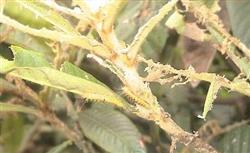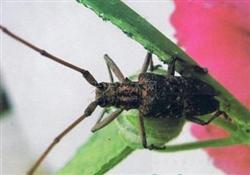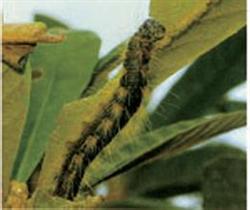Timely control of loquat yellow caterpillar

Loquat yellow caterpillar adults are commonly known as "inverted butterflies". The larvae eat buds and tender leaves, and when rampant, they also endanger old leaves, tender stem barks, flowers and fruits, and only upper epidermis and veins remain in the injured leaves. The first instar larvae of the insect are clustered. The second year old began to disperse the harm, and the food intake increased greatly after the third year old. This insect is one of the most common and serious pests in loquat. According to the survey, the second generation of loquat yellow caterpillar appeared a peak on June 3 and hatched on June 12. As the first generation of yellow caterpillar larvae occurred in the mature period of loquat fruit this year, most of the fruits could not be controlled by drugs, so the occurrence of the second generation loquat yellow caterpillar was large, but there were differences among different fields. Therefore, all fruit growers are required to seriously investigate and seize the appropriate time to carry out prevention and control. Specific measures are as follows: 1. Artificial removal of larvae: the first instar larvae of Dendrolimus punctatus have the habit of clustering damage, and artificial removal of the first instar larvae can reduce the source of insects and get twice the result with half the effort. two。 Biological control: the main natural enemies of loquat yellow caterpillar are thigh wasp, camel wasp, golden wasp, cocoon wasp and so on. In production, attention should be paid to the protection and utilization of natural enemies, maintenance of ecosystem balance and control of the occurrence of the pest. 3. Pesticide control: spray 80% dichlorvos EC 1000 times or 2.5% Uranus EC 2500 times daily on June 19.
- Prev

Treatment of "empty bosom" of mango
Longicorn beetles belong to Coleoptera and Cerambycidae, which occur in mango producing areas of southern China. By feeding on the branches with larvae, the growth of the damaged plants is weakened, and in serious cases, the damaged branches are easy to be broken by the wind. The insect produces one generation a year, and it overwinters mainly as larvae, and a few pupae or adults can also overwinter in the pores. The following year.
- Next

How to strengthen the management of loquat in winter
Loquat yellow caterpillar MelanographiaflexilineataHampson, also known as tumor moth, belongs to Lepidoptera, Noctuidae. It is distributed in Nanjing, Anhui, Jiangxi, Hubei, Sichuan, Taiwan, Hainan, Guangdong, Guangxi and other producing areas in China. In addition to harming loquat, it also harms Baige, jackfruit and other plants. The characteristics of the harm.
Related
- Moge, come on! The staff of the peasant association in the producing area of cantaloupe were frightened when the crowd gathered.
- Causes and Solutions of low Fruit setting rate of Apple
- Symptoms and control measures of passion fruit virus disease
- Fruit growing lesson: how do apple orchards keep high yields?
- Can you build orchards in the mountains? What are the pros and cons?
- How to manage the coloring period of Crisson grape?
- This paper introduces the processing technology of two kinds of fig products.
- How much is a month for retired teachers in rural areas by 2020?
- How can strawberry planting increase sugar content? We should pay attention to management in many aspects.
- What are the cultivation techniques on how to improve the yield of golden fruit?

